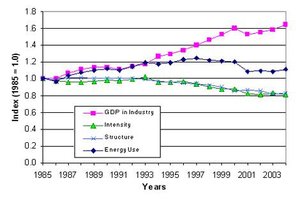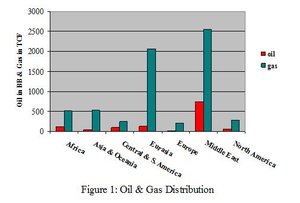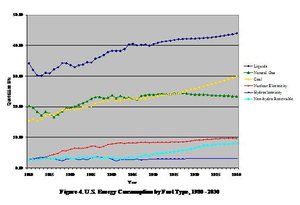Energy type, distribution, and consumption
Contents
- 1 Introduction Energy (Energy type, distribution, and consumption) is the capacity to do work and the lifeblood of civilizations, particularly so for modern industrialized civilizations. The level of energy consumption seems to be the benchmark for measuring the strength and wealth of a nation. The more developed a country, the greater amount of energy it demands. As population (Population growth rate) continues to grow and more developing nations, such as the BRICs (Brazil, Russia, India, and China), have entered industrialization, the global demand for energy has increased exponentially. The uneven distribution and disproportioned demand and consumption have compounded the energy problems. Beyond reasonable doubts, the world has come to the crossroad of formulating a sustainable energy strategy to deal with problems such as finite fossil fuel resources, imbalanced geospatial demand and supply, geopolitical instability associated with energy development, global climate changes in relation to the consumption of fossil fuels, and global economic wobbles under the weight of the energy price pendulum.
- 2 Energy Type
- 3 Energy Distribution
- 4 Energy Consumption by Sector
- 5 Energy Consumption by Fuel Type
- 6 References
- 7 Further Reading
Introduction Energy (Energy type, distribution, and consumption) is the capacity to do work and the lifeblood of civilizations, particularly so for modern industrialized civilizations. The level of energy consumption seems to be the benchmark for measuring the strength and wealth of a nation. The more developed a country, the greater amount of energy it demands. As population (Population growth rate) continues to grow and more developing nations, such as the BRICs (Brazil, Russia, India, and China), have entered industrialization, the global demand for energy has increased exponentially. The uneven distribution and disproportioned demand and consumption have compounded the energy problems. Beyond reasonable doubts, the world has come to the crossroad of formulating a sustainable energy strategy to deal with problems such as finite fossil fuel resources, imbalanced geospatial demand and supply, geopolitical instability associated with energy development, global climate changes in relation to the consumption of fossil fuels, and global economic wobbles under the weight of the energy price pendulum.
Energy Type
Earth has long been viewed as a dynamic organism. As such, it needs energy to power, operate and sustain. The earth has its external heat source from the Sun and its internal heat engine of the primordial heat from its accretion and compression due to the Big Bang. Different types of energy that is available for us to use are either directly from the two sources or derived from them (Table 1).
|
Table 1. Types of Energy in the Earth System | ||
|
|
|
|
|
|
|
|
|
|
|
|
|
|
|
|
|
|
|
|
|
|
|
|
|
|
|
|
|
|
|
|
|
|
|
|
Energy Distribution
Although there are many types of energy are available in the earth system, they are not all accessible to us under current economic and technological conditions. Consequently, fossil fuels, particularly oil and gas, have been the dominant energy sources used to power modern economies. The geological and geographic distribution of the fossil fuels is highly uneven. Geologically, most oil and gas is found and produced from sedimentary basins that reservoir rocks are typically less than 500 million years old and that most oil and gas is found in less than 100 million years old younger rocks. Approximately, 85% of oil and gas existed in less than 5% of large production field, and most of the oil and gas fields are located near plate boundaries. Geographically, it is estimated that the Middle East has more that 60% of the world oil reserves and 40% of the gas reserves. Based on the worldwide oil and gas reserve data from the BP Statistical Review, the geographic distribution of oil and gas by regions at the 2005 year end is shown in Figure 1.
Energy Consumption by Sector
 Figure 2. Energy Use, Energy Intensity, and Structural Effects in the Industrial Sector, 1985-2004. (Source: DOE)
Figure 2. Energy Use, Energy Intensity, and Structural Effects in the Industrial Sector, 1985-2004. (Source: DOE) No work can be done with the consumption of some forms of energy. To maintain and develop human societies, energy is needed for food production, shelter construction and space heating/cooling, transportation, industrial operations, and power generation. The U.S. embodies a consumption-based modern economy; its energy use reflects the trend of global energy demand and consumption for other rapid industrializing nations. The U.S. has about 4% of the world population, but used 22% of the world energy in 2005.
In the U.S. energy consumption, the primary end-user consumption includes residential, commercial, industrial, transportation uses. The residential consumption is often dictated by the physical characteristics of the housing structures (size, shape, building materials, geographic location and facing, landscape, and climate zone, etc), the number and types of appliances utilized in the house, socio-economic and demographic characteristics of the household. Electricity, natural gas, fuel oil, liquefied petroleum gas (LPG), and kerosene is commonly used for residential energy needs.
Commercial energy consumption is affected by several important aspects. It is affected by the physical building characteristics, much like the residential energy consumption. It is also related to the building use (principal commercial activities, normal and additional operating hours, number of employees, and type of ownership or occupancy. In addition, commercial energy consumption changes with the type and source of energy, such as electricity, natural gas, fuel oil, coal, and renewable energy from solar and wind. Two rates of consumption are often measured: Gross Energy Intensity (GEI) and Conditional Energy Intensity (CEI). GEI measures the total energy consumption per square feet, and CEI measures the total consumption of a particular form of energy per square feet of the floorspace powered by the energy. GEI is often used to measure the total energy consumption efficiency, while the CEI tracks and compares the energy efficiency by energy types and sources.
Industrial energy consumption is affected more by the type of industries than the physical characteristics of the building structures. For example, manufacture industrial energy use is very different from those of non-manufacture industries such as construction and fishery (Fisheries and aquaculture) industries. According to the U.S. Department of Energy (DOE), the total energy consumption has steadily increased before mid 1990s, then declined and leveled off. The energy intensity index has declined 19% since 1985, with the most of the decline since 1993 due to energy efficiency improvement and other factors (Figure 2)
Transportation energy consumption has increased dramatically worldwide. Energy is used for transporting people, goods, as well as energy from one place to another, far away and nearby. As more people are on the wheels, as more food and other goods are shipped around the globe, as more nations demand more energy than they produce, transportation energy consumption can only increase over time. Despite the efficiency improvements, the transportation energy use has increased by 42% from 1985 to 2004. For highway passenger transportation (passenger cars, trucks, and buses) in the U.S. alone, the energy use has increased by 73% from 1970 to 2004.
The total energy consumption by the four sectors has increased by 34% during the last 25 years (1973 to 2007). Based on the data from the Energy Information Administration (EIA), there are some shifts in energy consumption among the four end-user sectors (Figure 3). The transportation and commercial uses have increased, while the industrial consumption decreased. The changes (Energy transitions) indicate a shift from manufacture-based economy to service-based economy and the energy efficiency improvements.
Energy Consumption by Fuel Type
According to the Annual Energy Outlook 2008 by the U.S. EIA, energy use has been steadily increasing since mid 1980’s and will remain so for the next decades to come (Figure 4). Liquid fuels have been dominant form of energy consumption and provided about 80% to 90% of the total primary energy consumption. Renewable energy accounts for only less than 10% of the U.S. total energy consumption.
Globally, it has become increasingly difficult to achieve a dynamic equilibrium between energy demand and energy supply. Although there are many forms of energy, most technologically available, economically profitable, and heavily depended-upon energy source is fossil fuels. The spatial polarity and disparity between energy distribution and energy consumption add another layer of challenge. The future energy demand and consumption will be influenced by the availability of energy supply, the pace of economic growth, energy prices, energy efficiency and renewable energy development. Consequently, the environmental problems and economic effects associated with energy supply and energy uses need to be discussed separately.
References
- U.S. Department of Energy, Energy Intensity Indicators.
- Energy Information Administration, International Energy Outlook 2008.
- Energy Information Administration, Forecasts & Analyses.
- Solar Energy International, Energy Facts.
- Energy Information Administration International Energy Annual 2005.
Further Reading
- Keller E. A. 2000. Environmental Geology. 8th ed. Prentice Hall. ISBN: 0130224669.
- Kandilli, C.; Ulgen, K. 2008. Solar Illumination and Estimating Daylight Availability of Global Solar Irradiance. Energy Sources Part A: Recovery, Utilization & Environmental Effects, 30 (12): 1127-1140.
- Martinot, E., Dienst, C., Liu W., Chai Q. 2007. Renewable Energy Futures: Targets, Scenarios, and Pathways. Annual Review of Environment & Resources, 2007, 32(1): 205-239.
- Pacella, R. M. 2008. Harnessing Energy from Tornadoes. Popular Science, 2008, 273(1): 46


